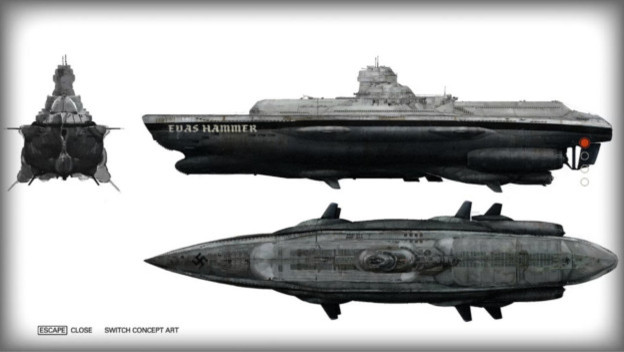After finally got the chance to take a peek at Wolfenstein II: The New Colossus, thanks to a friend of mine, I had one overriding thought as I played through the tutorial. This is supposed to be taking place on a U-Boat, right? That U-Boat was of course Eva’s Hammer, the location in which William Joseph “B.J.” Blazkowicz awakens and must attempt to escape from. He’s still wheelchair bound, having not completely recovered from previous injuries. (Which, by the way, would make getting around in a god dang U-Boat pretty difficult.) This U-Boat must be the size of the ever-loving Titanic.
B.J. seems to never-endingly scoot around Eva’s Hammer as he searches for a way out, over door jams that should be much difficult for a wheelchair to handle and massive gears that supposedly run the ginormous U-Boat engines. I don’t know about you, but when I think of a U-Boat, I think of films like U-571 or Das Boot . Submarines were small, dark, dingy, narrow places that barely had enough room for the crew it took to run them. Eva’s Hammer absolutely does not fit any of these descriptors. To be fair, Eva’s Hammer was based on plans for a Kriegsmarine Cruiser Class U-Boat that would have been able to carry a seaplane and a helicopter within it, so that would have been pretty large. There were even Japanese Navy submarines called the I-400-class that could carry up to three floatplanes. Even with those in consideration though, Eva’s Hammer is still quite massive.
It’s funny how much that thought kept repeating itself during my time with the tutorial. “How big is this thing?!” I actually said aloud as I continued to pass corner after corner. Don’t get me wrong, I absolutely enjoyed the beginning of Wolfenstein II: The New Colossus . This was a great way to set up a tutorial, as well as the rest of the story. I was left with wanting more. Also, please keep in mind that I am a firm supportive of video games shifting and altering reality to make it something new. This of course includes the size of real life locations.
The concept of video games taking liberties with the size of real life locations isn’t new by any means. Another example you can take is Mr. Slave’s butt in South Park: The Stick of Truth . I absolutely guarantee you that a butthole is not that big. But Mr. Slave’s rear end in Stick of Truth is pretty sizable nonetheless. There’s obviously nothing wrong with this, but it’s a funny thing if you stop and think about it. I mean obviously, it would not be big enough to support a role-playing game. More subtle is the U-Boat example in Wolfenstein II .

It wasn’t meant to be a point of notice, and yet my friend and I had a good laugh over the fact that this U-Boat was absolutely massive. Think about video games that use real life locations as well. What sort of liberties do they take? What kind of additions or subtractions do they make? Does playing Tokyo Jungle make me an expert on where all the different districts are? Almost certainly not, but it’s a fun way to relate video games to real life.
Just like a submarine can suddenly transform into an underwater Titanic for the sake of B.J. Blazkowicz needing to motor around it in a wheelchair for the entire first part of the game. It’s an exaggeration on real life that allows Wolfenstein II to happen. Sure, it’s not the most realistic thing when it comes to regular U-Boats, but it serves its purpose. We get an “inspired by” version of the real thing that allows us to enjoy the gameplay that we know and love.
Think for a minute about video game locations you’ve encountered that were much bigger than the real thing. Let me know what those were in the comments!
